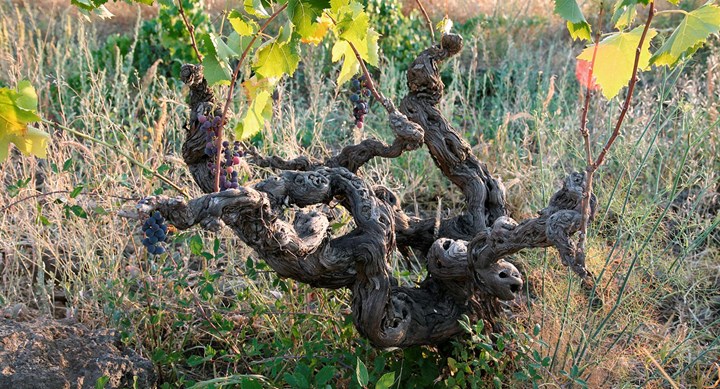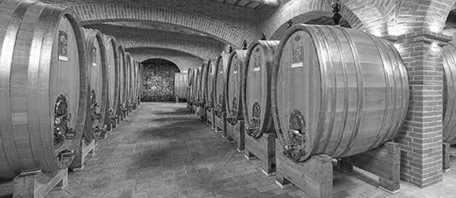
Which site would you like to visit?
By clicking the retail or wholesale site button and/or using rarewineco.com you are choosing to accept our use of cookies to provide you the best possible web experience.

Sicily’s Mount Etna has an ancient winemaking culture with many similarities to Barolo, including long aging in massive old botti and a focus on tannin structure and texture. The resulting delicate, tarry nuances of its wines evoke comparisons not only to Barolo, but to Burgundy as well. Jancis Robinson even once asked in the Financial Times if Etna is “the Burgundy of the Mediterranean?”
Today, only a few strive to uphold Etna’s traditional practices. But one great estate, Calabretta, continues to make its majestic reds as it did in the past, releasing them only when they feel the wines are ready.
Calabretta’s vineyards are located nearly a half mile above sea level in the black volcanic soils of Etna’s north slope, between Randazzo and Castiglione di Sicilia. There, Calabretta farms roughly seven hectares of mostly 70- to 80-year-old vines—many of them ungrafted—on stepped terraces supported by stone walls.
Since the winery’s founding in 1900, the Calabretta family has farmed and produced wines from Etna’s ancient indigenous varieties—including Nerello Mascalese and Nerello Cappuccio—in the mountain’s unique noble vineyards.
Historically, the family had sold its wine in sfuso or in barrel to restaurants and to private customers, many of whom travelled long distances to pick up their wine. But in 1997, third- and fourth-generation father and son Massimo and Massimiliano Calabretta decided to bottle their best wine under their own label to ensure the winemaking traditions of their family and Etna would not be lost.
Slow Food’s Slow Wine guide has described Calabretta’s style as “a thousand miles away” from other Italian wine, but the gap might be better measured in time, since the estate seems stuck somewhere in the 19th century.
The flagship wine here, the Nerello Mascalese Vigne Vecchie, has been made the same way throughout the family’s history as winegrowers. Formerly labeled just “Etna Rosso”, the wine ages much as the heroic Barolos and Brunellos of the past were, in massive (50- 70-hectoliter) neutral Slavonian oak botti for 6 to 7 years.
The vineyard practices, too, are rooted firmly in the past. Calabretta has never used chemical pesticides or herbicides, and they harvest by hand, starting around the second week of October. Fermentations are carried out exclusively with the native yeasts.
The resulting wine shares the firm structure and energetic drive of traditional Barolo but with the silken texture of classical Burgundy. And perhaps Etna’s most distinctive calling card, its volcanic mineral character, rings through with vivid clarity.
Put simply, Calabretta is one of Mount Etna’s last great traditionalist estates, and its wines are a true gift for those who appreciate classically made Italian wines.
The Nerello Mascalese Vigne Vecchie remains the estate’s crown jewel to this day. The extended aging sculpts the wine's velvety texture and subtle aromatics, making it dangerously delicious upon release while also imbuing it with a deceptively age-worthy structure. It coats your palate without a trace of excess weight, sliding towards a unique convergence of value, character, and age rarely seen in Italy, if not the world.
In addition to the Nerello Mascalese VV, Calabretta makes a dizzying array of other wines. Cala Cala Rosso is produced from younger Nerello vines and is usually blended from multiple vintages. A white from Carricante can be equally compelling, with driving acidity and refreshing mineral character.
There’s also a stimulating Rosato, which is bright and juicy with an undercurrent of volcanic complexity. And most recently, Calabretta has begun releasing single-contrada (cru) wines like his its ethereal Sara, source from Feudo di Mezzo.
Calabretta’s allegiance to Etna’s historic traditions, paired Massimiliano’s young and adventurous mind, ensure that while the past has been great, the best is yet to come.
| Year | Description | Size | Notes | Avail/ Limit |
Price | |
|---|---|---|---|---|---|---|
 2015
2015
|
2015 Calabretta Nerello Mascalese Vecchie Vigne |
VM93 / WS17+ |
12 | $29.95 | add |
New discoveries, rare bottles of extraordinary provenance, limited time offers delivered to your inbox weekly. Be the first to know.
Please Wait
Adding to Cart.
...Loading...


By clicking the retail or wholesale site button and/or using rarewineco.com you are choosing to accept our use of cookies to provide you the best possible web experience.

